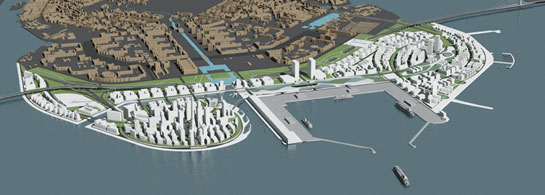
A rendering of what St. Petersburg might soon look like.
On the tenth of September, a massive Italian ocean liner, the Costa Mediterranea, with seventeen decks, three hundred meters in length, and sixty meters high – moored at the dock of the new passenger port “The Marine Façade” in St. Petersburg. The cruise ship delivered two thousand tourists there.
A new, one hundred hectare piece of land near Vasilyevsky Island in the Gulf of Finland was created for the construction of the passenger port. However, that is only the beginning of the ambitious project known as the “Marine Façade.” In total, 467 hectares of new, dry land will be deposited. On top of this, more than four million square meters of housing, offices, and other commercial space will be constructed. An estimated twelve billion dollars will be invested in the project.
Until now, ocean cruise liners could only dock in the St. Petersburg cargo port, and only on a limited basis. The new, specialized passenger port will give a powerful boost to the development of tourism in the city. In 2011, when all seven cruise ports are constructed, a total of 2,100 meters of mooring wall (basically “parking space” for boats), The Marine Façade will be able to take in up to 12,000 passengers at a time. Each year, new cruise tourists are expected to bring up to a quarter billion euros to St. Petersburg.
Now Arriving on the Gulf of Finland
The dream to construct a passenger port here was born in the 1960s, but was never realized. However, in 2004, the idea to create new lands in the bay near Vasilyevsky Island for the construction of a passenger port was put forward by a private operating company, also called “The Marine Façade.” The idea was supported by the administration of St. Petersburg, and the company prepared plans for developing the territory. During the planning, a large area with residential and commercial buildings was added to the plans. Original discussions spoke of creating about one million square meters of new land – but this figure has grown four times since then. A section of the sea territory in the Gulf of Finland was transferred federal control to the city of St. Petersburg for the project. Its original purpose was also changed – from a port project to a new residential neighborhood.
The Saint Petersburg City Administration put the land up for tender and the development rights were purchased (as expected) for five million dollars by New Terra, a company affiliated with The Marine Facade. The agreement states that The Marine Façade company will build the port by its own means, and the city administration is obligated to acquire the finished object by repaying the company’s bonded debt, including not only direct expenditures, but also loans and interest. Current forecasts put this figure at not less than 6 billion rubles.
The remaining newly created territories of The Marine Façade project will be divided in approximately half between the city and company. The non-income bearing half will become the property of the city of St. Petersburg to build kindergartens, schools, roads, parks, and other things necessary for the region to function. The company will receive about 150 hectares to build housing and a new, large downtown area – similar to Moscow’s new financial center development known as “Moskva Citi” – that will help unburden traffic in the city center.

A model of the new islands now under construction.
The new land is created on the modern hydroalluvium technology of sea sand. This technology makes it possible to sharply reduce the period of construction: if half a century ago, deposited territories had to be matured fifty years, then now the consolidation of ground occurs considerably more rapidly – it is possible to build on this site after only half a year.
Creating the first 100 hectares, construction of a port terminal and two docks, has taken less than two years and cost the company six billion rubles. The federal government has spent an additional eight billion rubles to deepen the channel in the Gulf of Finland to eleven meters to accommodate larger ships and also to upgrade traffic access to the port and to create new border entry points.
Future Land for Sale
The Marine Façade company is currently selling land in lots that it has yet to create. In June, Russian real-estate giant PIK acquired a 63.4 hectare site that is zoned for residential construction. How profitable is making artificial land? To judge this is difficult. The Marine Façade company disclosed neither the price of the transaction with PIK nor how much it had spent on creating the new land.
Industry experts say that its costs about three to five million dollars for one hectare of “deposited land,” but the price varies depending on the depth of the water, the type of coast, and a number of other factors. Judging by these various factors, we can estimate that the project in St. Petersburg will cost closer to the lower estimate.

A project photo from November, 2006 showing some of the machinery involved.
The average price of a small lot on Vasilyevsky Island two to four thousand dollars per square meter (twenty to forty million dollars per hectare). However, the market for large land plots in St. Petersburg does not exist, and it is clear that such large plots should cost considerably cheaper per square meter. Most likely, we can assume that even with a “bulk discount” that price this would not be less than five to ten million dollars per hectare.
Realtors highly estimate the potential of the new development. In contrast to most new development sites in St. Petersburg, this one is near the center and has excellent views of the Gulf of Finland and Neva. The main bottleneck is St. Petersburg’s transportation system. The subway is already operating at brink of capacity and traffic between Vasilyevsky Island and the mainland is currently highly congested at rush hour. The Marine Façade project will sharply increase the local population (plus 35,000 people) and create tens of thousands of new workplaces in the city. This will mean an enormous burden on the transport system.
Extending the subway system to will not provide enough transport capacity to save the project. The erection of two new bridges from Vasilyevsky to the city center is planned, but it is not clear when they will be constructed, and in any case they will rest in narrow streets of the old center.
St. Petersburg realtors believe for the project to be successful, the Western Diametrical Expressway must be completed. This new toll road will connect the south of the city with the north, with additional access to new Marine Façade project, and ease traffic through the center of the city. But the fate of that road is so far not clear.

The passenger port section seen nearly complete in August, 2008.
Zoning rules are also unclear in the The Marine Façade project. The average building height was zoned for 90 meters and a number of skyscrapers rising to 250 meters had been planned. This freedom from building height restrictions was one of the main attractions for the project. However, last year’s scandal over the proposed 400-meter “Gazprom City” (also known as the “Okhta Center”), has changed the situation in the city. The public protested in favor of preserving the city’s traditional flat silhouette and the famous St. Petersburg landscape. City authorities are now urgently developing newer, stricter, building height restrictions for the city’s various regions. Here, new uncertainties appear. On the one hand, the planning of the Marine Façade development as a region of tall buildings is already approved. On the other hand, the administration and the public will likely not be apathetic that, viewed from the Gulf of Finland, St. Petersburg will appear to be a congestion of skyscrapers rather than a historical city.
A Future in Artificial Land?
Artificial islands are one of the most fashionable directions in Russia for property development. Such projects exist in Voronezh, Kazan, Novorossisk and Nizhni Novgorod. Some artificial islands are planned for the Sochi region. All of these projects are still in development. Is it possible to consider that the completion of The Marine Façade project will help bring these other projects into being? Not really.

Another look at the planned future of St. Petersburg.
Imitating Dubai’s artificial “palm trees” seems strange in most cases for Russia. In fact, money-washed Dubai does not build into the sea simply because it has extra funds. In fact, it is because the country has only about 60 kilometers of developed coastline, and the rest is desert unfit for construction. Russia’s developers and municipalities often mimic, adopting the foreign ideas, and pursuing one purpose – to stand out, to shine. What project has the best chance to be allocated the limited resources of investor funds? Most likely, a fantastical skyscraper or an artificial island.
The enthusiasm for artificial islands in Russia is also ironic. In the county with the largest land reserves, there seems to be none to build on. Vast swaths of land belong to companies who are interested only in waiting for the land to increase in value. There is no thought-out plan for the spreading new developments. As a result, proposed projects often appear similar to those discussed in the Tula area: to build an island on the lake on which to put a skyscraper.
Developing land in Russia is such an entangled process that at times it seems to developers that pouring out new land would be easier than handling the thousands of hectares of empty land.
This article originally appeared in the Russian publication Expert (#36), under the name “Намыли!” The Russian term refers translates directly to “pan out.” It also has several other connotations, and is sometimes used as a slang word for bribes received by officials, in addition to referring to “sediments” (as are used to construct the new islands), and the idea of striking or finding gold (to which the English phrase also refers).
The original article was published in September, 2008 – written before the financial crisis. That crisis is now affecting real estate markets across Russia, Central Asia (particularly Kazakhstan), and most of the rest of the world. However, St. Petersburg city officials have stated that the island-building project will move forward and that funding is guaranteed. However, the project is likely to meet delays in the fact that the private builders, who are supposed to construct the commercial and residential buildings for the project, are delaying construction and even backing out of deals to purchase parcels of land to develop.



